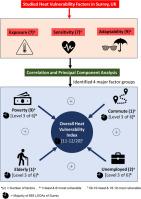评估英国东南部人口和社会经济对热浪的易感性
IF 10.5
1区 工程技术
Q1 CONSTRUCTION & BUILDING TECHNOLOGY
引用次数: 0
摘要
随着气候变化的加剧,热浪的频率和强度都在上升,对健康构成了重大威胁。受社会经济和人口因素影响的人口脆弱性受到广泛关注。我们对英国萨里郡一个非城市但却极易受热浪影响的案例研究进行了分析,结果表明,在较低的超级产出尺度下,对最近的本地化人口普查数据进行主成分分析,对贫困、获得冷却设施的机会、年龄和性别等脆弱性因素进行分析是非常有用的。确定了四个主要因素(贫困、老年人口、失业学生、日常通勤),形成了一个累积的高温脆弱性指数,有助于确定干预措施的优先次序和绘制脆弱地区地图。绘图结果显示,大多数地区在单个主要因素方面的脆弱程度为中度(6 分中的 3 分),累积分数为 11 到 12 分(20 分中的 12 分)。这项研究强调了脆弱因素之间的相互关联性,并突出了该方法在萨里以外地区的适用性。所展示的方法为面临类似挑战的地区提供了宝贵的脆弱性评估模板,其最新的有效高温行动计划强调了量身定制的全面高温风险管理战略(如冷却中心、交通援助、多语言风险沟通和家访)的重要性。政策制定者可以利用所获得的见解,为弱势群体制定有针对性的措施,并在全球范围内有效管理与高温有关的问题。本文章由计算机程序翻译,如有差异,请以英文原文为准。

Assessing demographic and socioeconomic susceptibilities to heatwaves in the Southeastern United Kingdom
As climate change intensifies, the frequency and intensity of heatwaves are rising to pose significant health risks. Population vulnerability, influenced by socioeconomic and demographic factors, is a widespread concern. We analysed heat vulnerability by demonstrating usefulness of principal component analysis on recent, localised census data at lower super output scale for vulnerability factors such as poverty, access to cooling facilities, age, and gender for a non-city yet highly heat risk vulnerable case study of Surrey, UK. Four major factors (poverty, elderly population, unemployed students, daily commute) were identified, creating a cumulative Heat Vulnerability Index, aiding in prioritising interventions and mapping vulnerable areas. Mapping revealed most areas had a moderate vulnerability level of 3 out of 6 for individual major factors, with cumulative scores ranging from 11 to 12 out of 20. The study emphasises the interconnectedness of vulnerability factors and highlights the applicability of the approach beyond Surrey. The demonstrated methodology provides a valuable template for vulnerability assessments in regions facing similar challenges and have its up-to-date effective heat action plan underlining the importance of tailored strategies for comprehensive heat risk management (e.g. cooling centres, transport aid, multilingual risk communication and home visits). Policymakers can utilise the insights gained to develop targeted measures for vulnerable populations and manage heat-related issues effectively on a global scale.
求助全文
通过发布文献求助,成功后即可免费获取论文全文。
去求助
来源期刊

Sustainable Cities and Society
Social Sciences-Geography, Planning and Development
CiteScore
22.00
自引率
13.70%
发文量
810
审稿时长
27 days
期刊介绍:
Sustainable Cities and Society (SCS) is an international journal that focuses on fundamental and applied research to promote environmentally sustainable and socially resilient cities. The journal welcomes cross-cutting, multi-disciplinary research in various areas, including:
1. Smart cities and resilient environments;
2. Alternative/clean energy sources, energy distribution, distributed energy generation, and energy demand reduction/management;
3. Monitoring and improving air quality in built environment and cities (e.g., healthy built environment and air quality management);
4. Energy efficient, low/zero carbon, and green buildings/communities;
5. Climate change mitigation and adaptation in urban environments;
6. Green infrastructure and BMPs;
7. Environmental Footprint accounting and management;
8. Urban agriculture and forestry;
9. ICT, smart grid and intelligent infrastructure;
10. Urban design/planning, regulations, legislation, certification, economics, and policy;
11. Social aspects, impacts and resiliency of cities;
12. Behavior monitoring, analysis and change within urban communities;
13. Health monitoring and improvement;
14. Nexus issues related to sustainable cities and societies;
15. Smart city governance;
16. Decision Support Systems for trade-off and uncertainty analysis for improved management of cities and society;
17. Big data, machine learning, and artificial intelligence applications and case studies;
18. Critical infrastructure protection, including security, privacy, forensics, and reliability issues of cyber-physical systems.
19. Water footprint reduction and urban water distribution, harvesting, treatment, reuse and management;
20. Waste reduction and recycling;
21. Wastewater collection, treatment and recycling;
22. Smart, clean and healthy transportation systems and infrastructure;
 求助内容:
求助内容: 应助结果提醒方式:
应助结果提醒方式:


